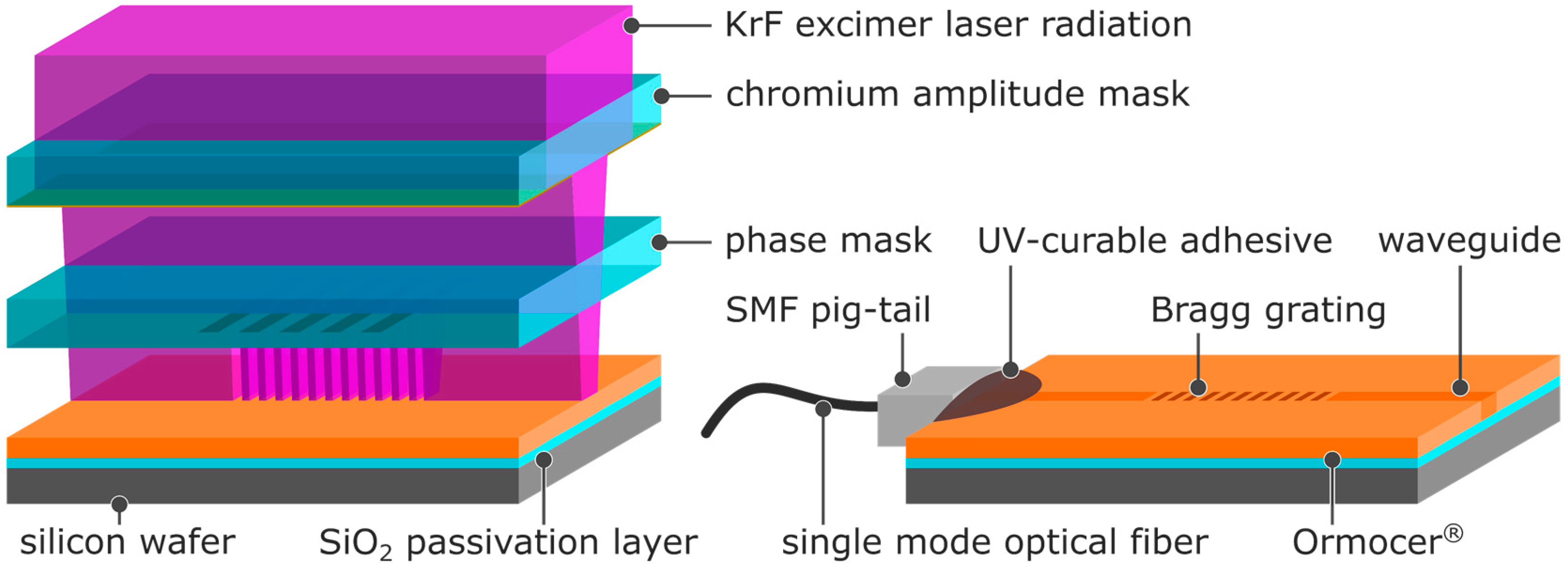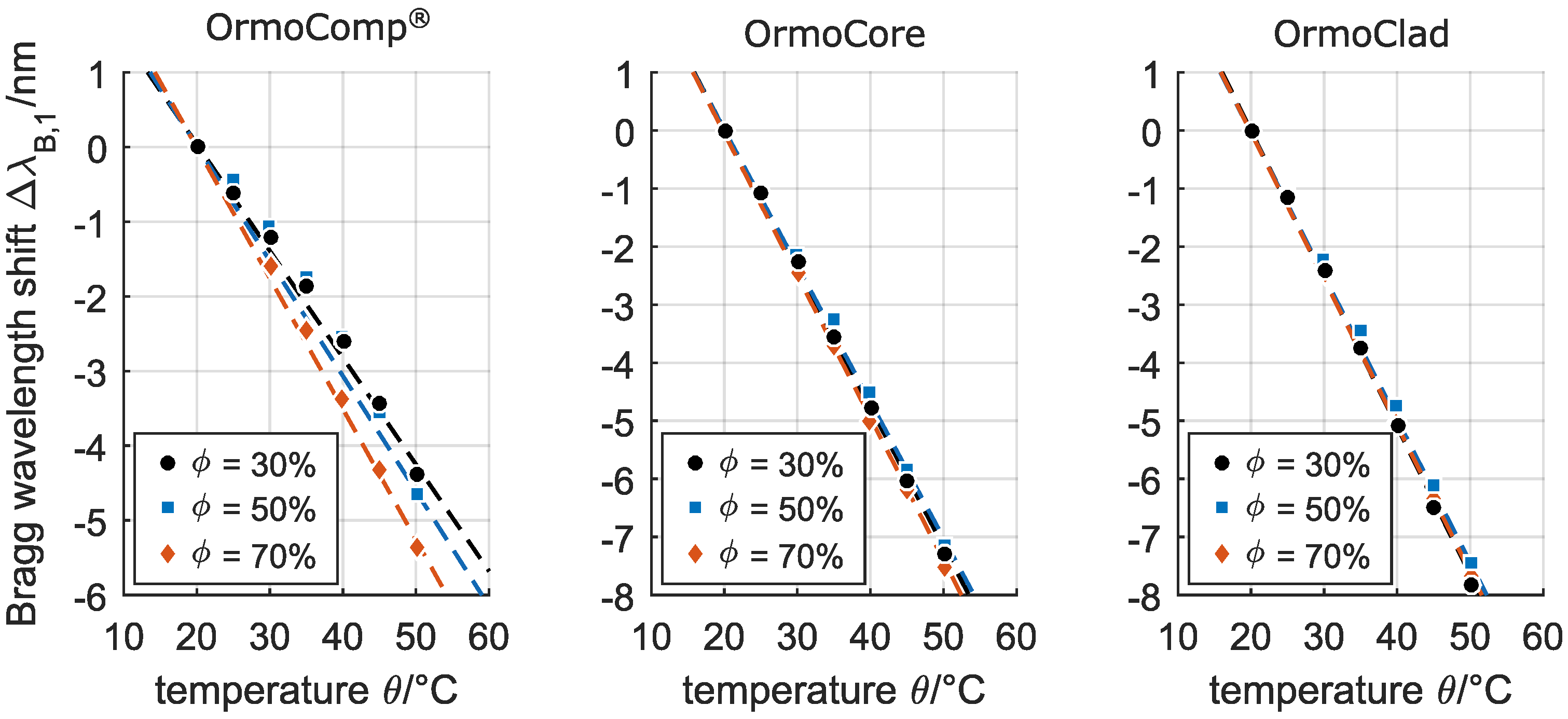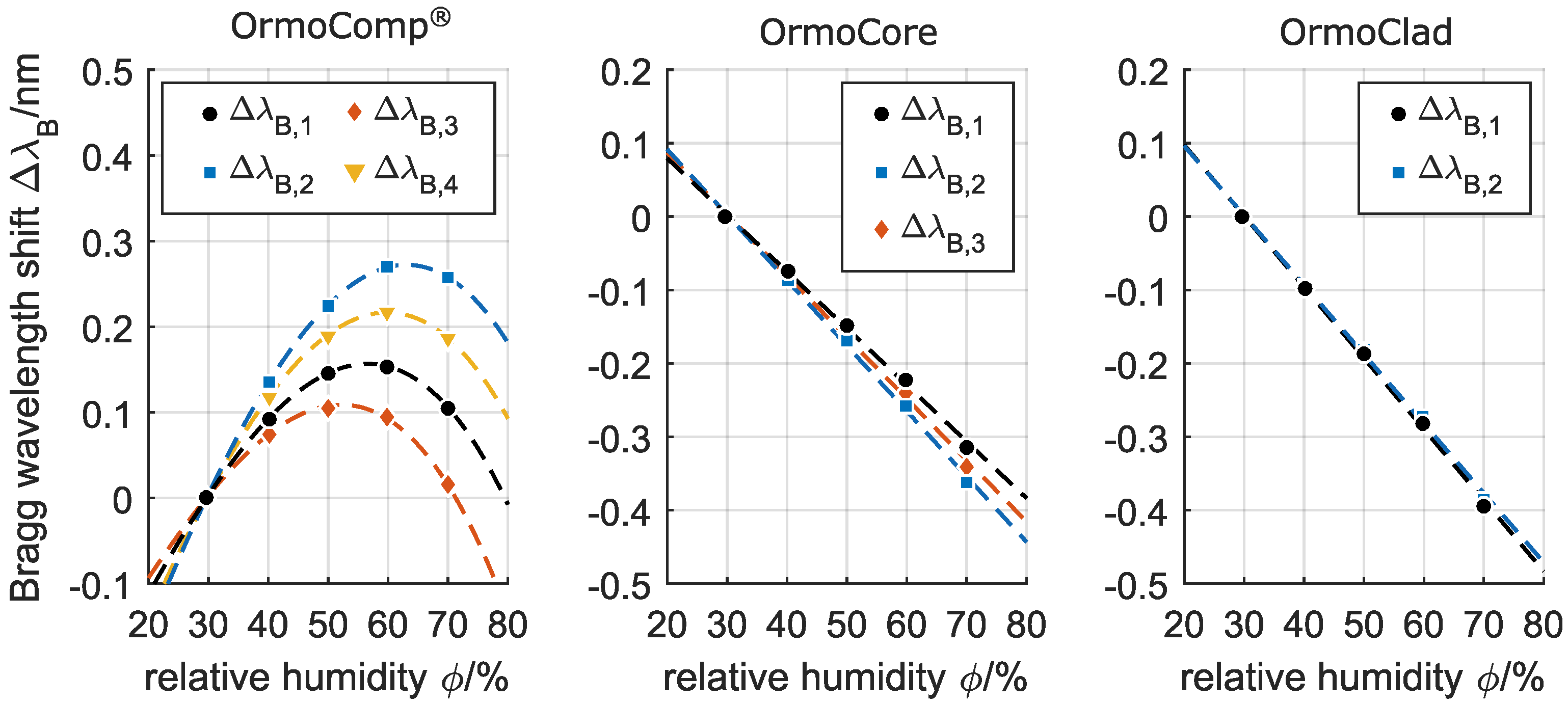Waveguide Bragg Gratings in Ormocer®s for Temperature Sensing
Abstract
:1. Introduction
2. Sensor Fabrication
3. Experimental
4. Results and Discussion
5. Conclusions
Acknowledgments
Author Contributions
Conflicts of Interest
Appendix A. Details on the Simulation-Based Bragg Peak Assignment
References
- Cusano, A.; Cutolo, A.; Albert, J. Fiber Bragg Grating Sensors: Research Advancements, Industrial Applications and Market Exploitation; Bentham Science Publishers: Tamil Nadu, India, 2011. [Google Scholar]
- Hill, K.O.; Meltz, G. Fiber Bragg grating technology fundamentals and overview. J. Lightwave Technol. 1997, 15, 1263–1276. [Google Scholar] [CrossRef]
- Othonos, A. Fiber Bragg gratings. Rev. Sci. Instrum. 1997, 68, 4309–4341. [Google Scholar] [CrossRef]
- Morey, W.W.; Meltz, G.; Glenn, W.H. Fiber optic Bragg grating sensors. Fiber Opt. Laser Sens. VII 1989, 1169, 98–107. [Google Scholar]
- Rao, Y. Recent progress in applications of in-fibre Bragg grating sensors. Opt. Lasers Eng. 1999, 31, 297–324. [Google Scholar] [CrossRef]
- Waxler, R.M.; Cleek, G.W. The effect of temperature and pressure on the refractive index of some oxide glasses. J. Res. Natl. Bur. Stand. Sect. A Phys. Chem. 1973, 77A, 755–763. [Google Scholar] [CrossRef]
- Lee, B. Review of the present status of optical fiber sensors. Opt. Fiber Technol. 2003, 9, 57–79. [Google Scholar] [CrossRef]
- Bai, B.; Guo, Y.; Zhao, X.; Huo, J.; Sun, T. Temperature and Strain Characteristic Analysis of Fiber Bragg Grating Sensor. In Proceedings of the 2012 International Conference on Information Technology and Software Engineering; Lu, W., Cai, G., Liu, W., Xing, W., Eds.; Springer: Berlin/Heidelberg, Germany, 2013; Volume 210, pp. 641–647. [Google Scholar]
- Jin, L.; Zhang, W.; Hao, Z.; Bo, L.; Jian, Z.; Tu, Q.; Kai, G.; Dong, X. An embedded FBG sensor for simultaneous measurement of stress and temperature. IEEE Photonics Technol. Lett. 2006, 18, 154–156. [Google Scholar] [CrossRef]
- Liu, Y.; Guo, Z.; Zhang, Y.; Chiang, K.S.; Dong, X. Simultaneous pressure and temperature measurement with polymer-coated fibre Bragg grating. Electron. Lett. 2000, 36, 564. [Google Scholar] [CrossRef]
- Zhang, C.; Zhang, W.; Webb, D.J.; Peng, G.D. Optical fibre temperature and humidity sensor. Electron. Lett. 2010, 46, 643. [Google Scholar] [CrossRef]
- Johnson, I.P.; Yuan, W.; Stefani, A.; Nielsen, K.; Rasmussen, H.K.; Khan, L.; Webb, D.J.; Kalli, K.; Bang, O. Optical fibre Bragg grating recorded in TOPAS cyclic olefin copolymer. Electron. Lett. 2011, 47, 271. [Google Scholar] [CrossRef] [Green Version]
- Rosenberger, M.; Hessler, S.; Belle, S.; Schmauss, B.; Hellmann, R. Fabrication and characterization of planar Bragg gratings in TOPAS polymer substrates. Sens. Actuators A Phys. 2015, 221, 148–153. [Google Scholar] [CrossRef]
- Wochnowski, C.; Abu-El-Qomsan, M.; Pieper, W.; Meteva, K.; Metev, S.; Wenke, G.; Vollertsen, F. UV-laser assisted fabrication of Bragg sensor components in a planar polymer chip. Sens. Actuators A Phys. 2005, 120, 44–52. [Google Scholar] [CrossRef]
- Buestrich, R.; Kahlenberg, F.; Popall, M.; Dannberg, P.; Müller-Fiedler, R.; Rösch, O. ORMOCER®s for Optical Interconnection Technology. J. Sol-Gel Sci. Technol. 2001, 20, 181–186. [Google Scholar] [CrossRef]
- Haas, K.H.; Wolter, H. Synthesis, properties and applications of inorganic-organic copolymers (ORMOCER®s). Curr. Opin. Solid State Mater. Sci. 1999, 4, 571–580. [Google Scholar] [CrossRef]
- Rosenberger, M.; Girschikofsky, M.; Schmauss, B.; Hellmann, R. Fabrication of Bragg gratings in planar PMMA: Impact of UV dosage and thermal annealing. Opt. Express 2016, 24, 22563–22572. [Google Scholar] [CrossRef] [PubMed]
- Rosenberger, M.; Hessler, S.; Belle, S.; Schmauss, B.; Hellmann, R. Humidity-Induced Effects on Polymer Planar Bragg Gratings. IEEE Photon. Technol. Lett. 2014, 26, 1669–1671. [Google Scholar] [CrossRef]
- Webb, D.J. Fibre Bragg grating sensors in polymer optical fibres. Meas. Sci. Technol. 2015, 26, 92004. [Google Scholar] [CrossRef]
- Processing Guidelines—OrmoComp, 2012-11-5; Micro Resist Technology: Berlin, Germany, 2012.
- Processing Guidelines—OrmoCore and OrmoClad, 2012-11-23; Micro Resist Technology: Berlin, Germany, 2012.






© 2017 by the authors. Licensee MDPI, Basel, Switzerland. This article is an open access article distributed under the terms and conditions of the Creative Commons Attribution (CC BY) license (http://creativecommons.org/licenses/by/4.0/).
Share and Cite
Girschikofsky, M.; Rosenberger, M.; Förthner, M.; Rommel, M.; Frey, L.; Hellmann, R. Waveguide Bragg Gratings in Ormocer®s for Temperature Sensing. Sensors 2017, 17, 2459. https://doi.org/10.3390/s17112459
Girschikofsky M, Rosenberger M, Förthner M, Rommel M, Frey L, Hellmann R. Waveguide Bragg Gratings in Ormocer®s for Temperature Sensing. Sensors. 2017; 17(11):2459. https://doi.org/10.3390/s17112459
Chicago/Turabian StyleGirschikofsky, Maiko, Manuel Rosenberger, Michael Förthner, Mathias Rommel, Lothar Frey, and Ralf Hellmann. 2017. "Waveguide Bragg Gratings in Ormocer®s for Temperature Sensing" Sensors 17, no. 11: 2459. https://doi.org/10.3390/s17112459
APA StyleGirschikofsky, M., Rosenberger, M., Förthner, M., Rommel, M., Frey, L., & Hellmann, R. (2017). Waveguide Bragg Gratings in Ormocer®s for Temperature Sensing. Sensors, 17(11), 2459. https://doi.org/10.3390/s17112459





